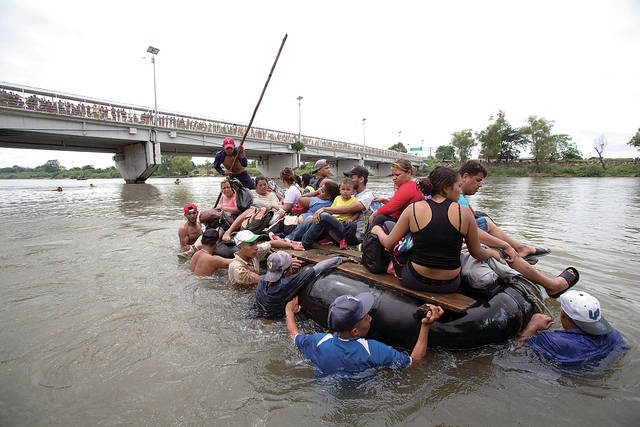CIUDAD HIDALGO, Mexico — About 2,000 Central American migrants who circumvented Mexican police at a border bridge and swam, forded and floated across the river from Guatemala decided on Saturday to re-form their mass caravan and continue their trek northward toward the United States.
Gathered at a park in the border city of Ciudad Hidalgo, the migrants voted by a show of hands and then marched to the bridge to urge those still there to cross the river and join them.
“Let’s all walk together!” and “Yes we can!” they cried, defying warnings to turn back this week from U.S. President Donald Trump, who has sought to make the caravan and border security in general into a campaign issue a little over two weeks before midterm elections.
The group’s decision capped a day in which Mexican authorities again refused mass entry to migrants on the bridge, instead accepting small groups for asylum processing and giving out 45-day visitor permits to some of them.
Mexico had sought to maintain order after a chaotic Friday in which thousands rushed across the bridge only to be halted by a phalanx of officers in riot gear. Authorities began handing out numbers for people to be processed in a strategy seen before at U.S. border posts when dealing with large numbers of migrants.
But despite a continued heavy police deployment on the bridge, a steady stream of migrants made it to Mexican soil with relative ease by crossing the Suchiate River that demarcates the notoriously porous border.
They swam, waded with the aid of ropes or paid locals who charge the equivalent of $1.25 to ferry people and goods across the muddy waters, and were not detained on reaching the Mexican bank.
“We don’t yet know if we will make it to the (U.S.) border, but we are going to keep going as far as we can,” said Rodrigo Abeja, one of the migrants’ leaders, adding that they would strike out Sunday morning for the city of Tapachula.
Where easily 3,000 people were on the bridge the previous day, the crowd had thinned out considerably by Saturday. In addition to those who crossed the river, immigration agents processed migrants in small groups and then bused them to an open-air, metal-roof fairground in Tapachula, where the Red Cross set up small blue tents on the concrete floor.
But the pace was slow, frustrating those who remained on the bridge in hot and cramped conditions.
“Please let us in, we want to work!” they entreated agents at the main gate. Behind it, workers erected tall steel riot barriers to channel people in an orderly fashion.
Each time a small side gate opened to allow people to pass, there was a crush of bodies as migrants desperately pushed forward.
Scarleth Cruz hoisted a crying, sweat-soaked baby girl above the crowd, crying out: “This girl is suffocating.”
Cruz, 20, said she was going to ask for political asylum because of threats and repression she faced back in Honduras from President Juan Orlando Hernandez’s governing party.
“Why would I want to go to the United States if I’m going to be persecuted” there as well, she said.
Mexico’s Interior Department said in a statement that it had received 640 refugee requests by Hondurans at the border crossing. It released photos of migrants getting off buses at a shelter and receiving food and medical attention.




